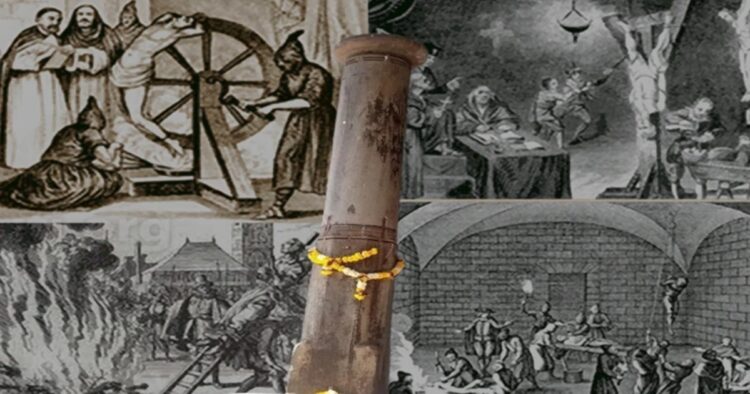It is important to reflect on the overlooked history of Hindu suffering during the Portuguese rule in Goa. The Hatkatro Khamb, or the “Pillar of Severed Hands,” located in Old Goa, stands as a stark and haunting testament to the horrors endured by Hindus who resisted forced conversions to Christianity.
The Hatkatro Khamb is not just a relic of the past but a witness to the brutal oppression faced by Hindus during the Goa Inquisition. Thousands of Hindus were tied to this pillar and had their hands brutally severed for refusing to abandon their faith. This barbaric act, carried out under the orders of Francis Xavier, who is ironically revered as a saint, marked one of the darkest chapters in Indian history.
Among the victims were countless Konkan Brahmins, many of whom were forced to flee to Maharashtra and Karnataka. Those who survived carried the scars of a tyrannical regime that sought to erase their cultural and spiritual identity. The Goa Inquisition, which spanned over 250 years from 1560 to 1812, was marked by a level of violence and fanaticism unparalleled in the history of Christianity. Established with the approval of Francis Xavier, this tribunal unleashed terror on Hindus who refused to convert, as well as those suspected of secretly practicing their faith after conversion.
The systematic demolition of Hindu Mandir was a cornerstone of the inquisition. Churches were often built on the ruins of these sacred sites, symbolising the erasure of indigenous culture. The inquisition tribunal operated from the “Big House,” a grim palace equipped with torture chambers and prison cells. Hindus were subjected to inhumane torture, including flogging, dismemberment, and burning at the stake.
Hindus who converted to Christianity under duress were compelled to renounce their customs and traditions. Any deviation was punished with extreme cruelty. Hindu women who resisted the advances of Portuguese officials were imprisoned, violated, and later executed under false charges of heresy. Located in Old Goa, this palace served as the epicenter of the inquisition. It housed over 200 cells where men, women, and even children were tortured.
The screams of the victims echoed through the streets, a grim reminder of the horrors within. Prisoners were subjected to mock trials, often based on false accusations, and faced unimaginable punishments. Despite the relentless oppression, Hindus in Goa displayed remarkable resilience. Many chose death over conversion, and their sacrifices have left an indelible mark on history. The diaspora of Goan Hindus to regions like Maharashtra and Karnataka ensured that elements of their cultural and spiritual heritage survived, albeit in exile.
Today, the Hatkatro Khamb stands in a state of disrepair, its historical significance largely ignored. The chains that once adorned its sides have been stolen, and there are no protective measures or plaques to educate visitors about its grim history. Unlike Holocaust memorials in Europe, which serve as powerful reminders of past atrocities, this monument to Hindu suffering is neglected and forgotten.
Countries like Germany, the USA, and Russia have memorialised sites of historical atrocities to ensure that the mistakes of the past are not repeated. India must adopt a similar approach to the Goa Inquisition, preserving the Hatkatro Khamb as a site of remembrance and reflection.

















Comments